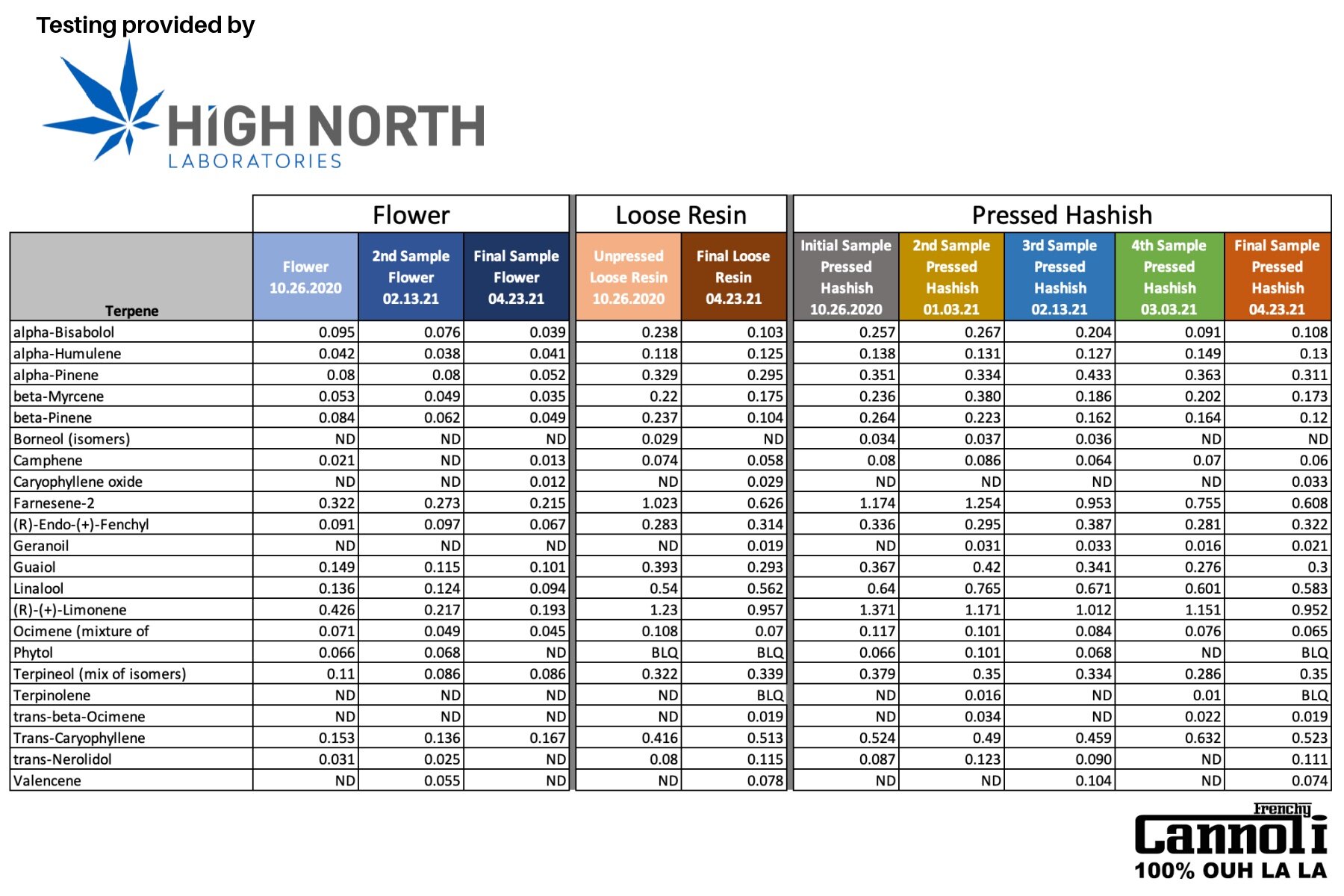Trichome Research Initiative
Frenchy Cannoli Launches Research on Aging Hashish
We are pleased to announce the launch of the Trichome Research Initiative. This initial study is a collaboration between @FrenchyCannoli of Frenchy Cannoli Brands, Lachlan Cheng of (@cannabinerd) of Cannabinerd Consulting, and Rick Moriarity of @HighNorthLabs.
Hashish aficionados are already aware of the subtle transformations that occur in aged hashish. Our inaugural study will document the stages of transformation as a ball of pressed hashish is tested in controlled conditions over the course of six months to establish a baseline for future studies and look for chemical indicators of the aging process.
The material to be studied is a single source input of cured dry flower (Sonic screwdriver bred by @homegrownnaturalwonders) sieved using an ice-water sieving methodology perfected by Frenchy Cannoli and freeze-dried prior to processing. Initial testing has been carried out on the unprocessed flower, the unpressed trichome resin glands, and the pressed hashish material.
In keeping with the Frenchy Cannoli Open-Source commitment, we will be sharing updates on the progress of our study and related studies as they become available. Follow @TrichomeResearchInitiative on IG for regular updates on our research and discussions that they inspire.
Thanks to @subsidiumsecreto for assistance in the initial processing phase.
The Art of Aging by Frenchy Cannoli
Aging is the act of leaving a product under specific conditions over a period of months or years to enhance its flavor, aroma, appearance, or texture. Aging is an art form. The transformation over time can produce greatness in products like wine, liquor, cheese, fish, meat or tobacco, and is the culmination of a symbiosis between the natural elements, time, and the human touch. Aging is an important part of French culture that acknowledges the benefits, the enhancement of the gustatory experience.
Since aged products are very attractive to a French person, you can imagine my interest when I was offered the opportunity to smoke a twelve-year-old Royal Nepalese Temple Ball in Katmandu. I had no idea at the time that charas (hand-rubbed live plant cannabis resin) or hashish (dry sieved cannabis resin made from plants that have been dried and cured and pressed with a source of heat) could be aged. The Royal Nepalese Temple Ball was already legendary in the 1980s. In the circle of cannabis enthusiasts traveling in the region at the time everyone had heard tales of the mythical temple ball, but I didn’t know anyone who had actually smoked one.
A Royal Nepalese Temple Ball is the epitome of resourcefulness from people who had a deep understanding of cannabis resin with a focus on preservation in a high mountain area with a tropical climate. The true origins of this natural approach to packaging and aging may never be uncovered but the technique is visionary in its simplicity and efficiency. A Royal Nepalese Temple Ball is a perfect unblemished sphere of resin made from many pieces of Charas slowly pressed into a solid mass creating a flawless surface. The ball is then rubbed vigorously over a smooth working surface like an enamel plate until the outside layer of resin fuses into a hard protective shell-like Parmesan cheese or an eggshell. The surface resembles a dark and dull polished river stone. The outside protective layer, not much thicker than a matchstick, is so blemish-free that it not only protected the resin within for years but also created an environment where the quality was enhanced over time.
Most of my experiences with aged charas occurred during the eight seasons I spent in Northern India. When I was there in the 1980s few foreigners lived there full-time. It was a loose community of French and Italian expats making charas annually, who religiously buried some of their best charas from the season well-wrapped and stored in metal containers. At the same time, they would also unearth some of their aged stash from previous years, a local harvest tradition. It was a source of wonder and the origin of my fascination with aging cannabis resin. The resin’s transformation over the years, the change in texture, potency, smoothness, flavor, and aroma was unbelievable. The difference between fresh and aged hand-rubbed charas is considerable. A few days will already mellow the smoke, but it is wise to wait at least a few weeks for the flavors and aromas to develop further.
While being a world apart from fermentation, the chemical reaction generated by pressing loose trichome glands with a source of heat into a mass which contains in its body, the cellular matrix, that created the resin with the cannabinoids, terpenes, and other organic matter, has a vast potential for transformation, nonetheless. The natural corrosiveness of the terpenes has to be central to the process by dissolving and absorbing the membrane material, lipids, and other compounds of the trichome glands into the resin mass. In their research paper Multidimensional analysis of cannabis volatile constituents: Identification of 5,5-dimethyl-1-vinylbicyclo hexane as a volatile marker of hashish, the resin of Cannabis sativa L.[i], Jean-Jaques Filippi, Marie Marchini, Céline Charvoz, Laurence Dujourdy, and Nicolas Baldovini demonstrated that the processes of isomerization, dehydration, cyclization, and more specifically, photo-oxidation are also crucial factors in the transformation process.
Aging is not simply storing. Aging requires the appropriate conditions to trigger the transformation to greatness. The research paper, The role of time and storage conditions on the composition of hashish and marijuana samples: A four-year study[ii] which assesses the degradation of cannabis flower and hashish in different “real life” storage conditions is instructive on the basic principles of storing. Oxygen, light, and temperature are the cause of cannabis flower and hashish deterioration over time. Each of these elements generates a specific sort of degradation during storage. The effect of oxygen is not as significant as the impact of light which influences important parameters in the polymerization process (the kinetic constants) of THC degradation into CBN and of the quantitative ratios of the conversion of THC into CBN (the stoichiometry). The temperature affects only the speed of the conversion of THC into CBN. Time is the very essence of degradation. In this study, there were two lighting parameters: non-stop 24 hour light exposure or no light, and three temperature variables: 71.6°F (22°C), 39.2°F (4°C), and - 4°F (- 20°C). The THC levels of the material stored at 71.6°F and 39.2F independent of the light exposure showed almost completely degraded into CBN over the four years of the study.
Interestingly, research done on the oldest evidence of psychoactive cannabis flower found unearthed in a 2,700-year-old tomb at the edge of the Taklamakan desert in Eastern China[iii] found evidence of THC. The 800 grams of cannabis found was stored in a leather basket and wooden bowl, barely adequate storage conditions but as far as “real life” storage conditions, this was as real as it gets. The phytochemical and genetic analysis of the cannabis flower indicated that “there was a very small peak detected at the correct retention time in the sample for THC, but the spectra could not confirm its identity.” If a minute trace of THC can be detected in a 2,700-year-old sample of cannabis flower stored in what can be considered extremely adverse conditions, how can THC degrade almost completely into CBN in a matter of four years in a controlled “real life” environment study? More data is needed!
Aging hashish is very much like aging wine. It requires full control of the natural elements - oxygen, light, and temperature – during storage. However, without knowing the chemical transformations that are occurring within the resin as it ages, we stand at a point in history similar to the wine industry in the late 1800s. Good wines were made, but the great wines we enjoy today would never have been created without the discovery and understanding of the fermentation process. The potential for great aged cannabis resin is for me a fact, and I believe that the impact aging hashish will have on tomorrow's cannabis market will be as important as aging has been for the wine industry. However, since my opinions are based on personal experiences, it is crucial to discover the science behind the transformation to validate my hypothesis and experience. To this end, I created the Trichome Research Initiative with Lachlan Cheng of Cannabinerd Consulting (@cannabiberd), and Rick Moriarity of High North Labs (@highnorthlabs). The press and aged hashish in the study will be tested monthly in a controlled laboratory environment to follow the transformative evolution of the compounds over the course of six months. I look forward to seeing how this transforms during the aging process. We look forward to sharing the results of our work with everyone over the course of the study.
[i] Multidimensional analysis of cannabis volatile constituents: Identification of 5,5-dimethyl-1-vinylbicyclo hexane as a volatile marker of hashish, the resin of Cannabis sativa L.
[ii] The role of time and storage conditions on the composition of hashish and marijuana samples: A four-year study by Luca Zamengoa, Chiara Bettina, Denis Badoccob, Valerio Di Marcob, Giorgia Mioloc, Giampietro Frison
[iii] https://www.ancient-origins.net/artifacts-other-artifacts/high-times-ancient-china-2700-year-old-marijuana-stash-found-shaman-grave-021722
Six-Month Study Results: The Cannabinoids
Six Month Study Results: The Terpenes
“We are scratching the surface and looking at the transformations happening in this initial study in order to better define future studies to understand the science behind the aging process in traditional hashish.” Frenchy Cannoli
“The cannabinoid transformations for d9 and THCV seem most interesting to me as they both appear only in the aged samples and seem to increase over time. It would really help to characterize the "hash" high if on top of novel terpenes there was a standard shift in cannabinoids towards these "rarer" types. Lachlan Cheng
Q&A from the Study
Have you made a tool to take a core sample from edge to center mass? No. Samples are cut from the balls, almost like taking a slice of pie and then homogenized prior to testing.
What will the study be looking at? Stability of the phytochemicals over time? Will you be comparing loose glands from those that have been caramelized or only looking at processed glands? We will be looking at the stability of the phytochemicals and changes over time. For example, photooxidation by light.
As a result of aging new compounds can appear. Is it going to be a targeted or untargeted study? Both.
Did you studied also at different temp or light exposure for the same homogenous sample? No, we've tried to avoid any variance at this level by keeping the samples in a controlled, stable environment with a fixed room temperature and humidity for the duration of the study.
Why is there an increase in terpenes from unpressed to pressed Statistical aberration? We're not sure yet. We'll need further tests to see how this progresses before we can comment on this.




